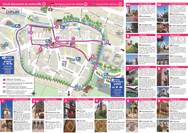History
Obernai: A little history...

A Roman crossroads, then a Merovingian royal villa, “Ehenheim” was first mentioned in 778 and was named Oberehnheim in 1242 to distinguish it from Niederehnheim (Niedernai).
The town is thought to have been the property of the Dukes of Alsace, then of the convents of Hohenburg (now Mont Sainte-Odile) and Niedermunster, both founded by St Odile and her father.
Obernai as an imperial town
Around 1240, Obernai freed itself from monastic control to gain the status of town, with the support of the royal Hohenstaufen family. This gave it legal and fiscal independence and allowed it to erect fortifications and to hold a market and fairs. In 1354, Obernai and the nine other imperial towns of Alsace (Wissembourg, Haguenau, Rosheim, Sélestat, Kaysersberg, Colmar, Turckheim, Munster and Mulhouse) came together to found the Décapole. This organisation was put in place with two priorities: to free the town from the authority of the provost (a representative of the Emperor) and to neutralise the influence of the town’s many noblemen.
The 16th century represented a golden age for Obernai. Crafts and wine-growing (for export) prospered. The Renaissance left its architectural mark on a number of buildings including the Hôtel de Ville (Town Hall, built 1523 and 1610), the Halle aux Blés (Corn Market, 1554), the Beffroi - Kapellturm tower and the Puits à Six Seaux well (1579). When the Thirty Years’ War (1618-1648) ravaged the region, the town was occupied and plundered.
Obernai as a royal town
Following the Peace of Westphalia treaties (1648), Louis XIV annexed the ten towns of the Décapole to the Crown of France in 1679. Obernai became a royal town and lost its autonomy. The 18th century would be another period of prosperity. Obernai had 306 master craftsmen working in 35 different trades, out of a total population of 5,000. After the French Revolution, the history of Obernai merged with that of Alsace. During the 19th century the urban landscape underwent significant changes: the town gates were destroyed and the roads and railways were developed. Obernai was annexed to Germany in 1871. The turn of the 20th century was marked by a new period of modernisation.
Despite the conscription to which the Mont National memorial bears witness, the town survived the destruction of the Second World War relatively unscathed and experienced a remarkable economic boom from the 1960s onwards, in the tourism sector in particular. Its population doubled in twenty years and Obernai became an important employment hub.
Obernai traditional dress

Instead of the red skirt and black headdress typical of Alsace, the traditional dress of Obernai women resembles the outfit worn by Queen Marie Antoinette when she dressed as a shepherdess for country fairs at Versailles.
It was the baroness of Oberkirch, a great friend of the Queen, who brought this outfit to the women of the middle classes and the nobility. The skirt is made of bright floral and pastel-coloured silk, and the small shawl of Valenciennes lace or embroidered linen to match the elegant apron. The velvet casaquin(jacket) is decorated with gathered white lace on the sleeves and at the neck.







